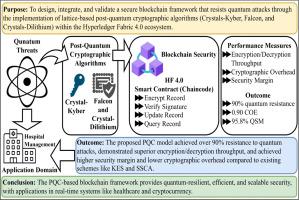通过集成后量子加密算法,增强区块链的安全性,抵御量子威胁
IF 4.9
3区 计算机科学
Q1 COMPUTER SCIENCE, HARDWARE & ARCHITECTURE
引用次数: 0
摘要
量子计算的快速发展给现有的密码系统带来了巨大的威胁,需要能够抵御量子攻击的后量子密码技术。本研究旨在通过结合鲁棒的后量子加密方法来提高区块链生态系统对量子相关威胁的安全性。我们提供了一种新的加密技术,它依赖于密钥加密过程,即Crystals-Kyber,结合了一种有效的数字签名方法,该方法以基于晶格的技术为中心:Falcon和crystals - dilithium。这些技术被精心包含在Hyperledger Fabric 4.0平台中,展示了围绕区块链技术构建的加密货币交易所的安全性和耐用性。我们有效地实现了对量子攻击的90%以上的密码抵抗,大大增强了对区块链操作的保护。提出的策略使密码设计对量子攻击具有更强的鲁棒性,为量子时代的安全区块链技术奠定了基础。本文章由计算机程序翻译,如有差异,请以英文原文为准。

Enhancing blockchain security against quantum threats through integration of post-quantum cryptographic algorithms
The fast progress in quantum computing presents a substantial menace to existing cryptographic systems, requiring post-quantum cryptographic techniques that can withstand quantum attacks. This research aims to increase the security of blockchain ecosystems against quantum-related threats by incorporating robust post-quantum cryptographic methods. We provide a new encryption technique that relies on the Key Encryption process, namely, Crystals-Kyber, in conjunction with an effective digital signature methodology centered on Lattice-based techniques: Falcon and Crystal-Dilithium. The techniques are meticulously included in the Hyperledger Fabric 4.0 platform, showcasing improved security and durability in cryptocurrency exchanges built around blockchain technology. We have effectively achieved a cryptographic resistance above 90 % against quantum assaults, greatly enhancing the protection of blockchain operations. The proposed strategy makes cryptographic design more robust to quantum attacks and establishes a basis for secure blockchain technology in the quantum era.
求助全文
通过发布文献求助,成功后即可免费获取论文全文。
去求助
来源期刊

Computers & Electrical Engineering
工程技术-工程:电子与电气
CiteScore
9.20
自引率
7.00%
发文量
661
审稿时长
47 days
期刊介绍:
The impact of computers has nowhere been more revolutionary than in electrical engineering. The design, analysis, and operation of electrical and electronic systems are now dominated by computers, a transformation that has been motivated by the natural ease of interface between computers and electrical systems, and the promise of spectacular improvements in speed and efficiency.
Published since 1973, Computers & Electrical Engineering provides rapid publication of topical research into the integration of computer technology and computational techniques with electrical and electronic systems. The journal publishes papers featuring novel implementations of computers and computational techniques in areas like signal and image processing, high-performance computing, parallel processing, and communications. Special attention will be paid to papers describing innovative architectures, algorithms, and software tools.
 求助内容:
求助内容: 应助结果提醒方式:
应助结果提醒方式:


